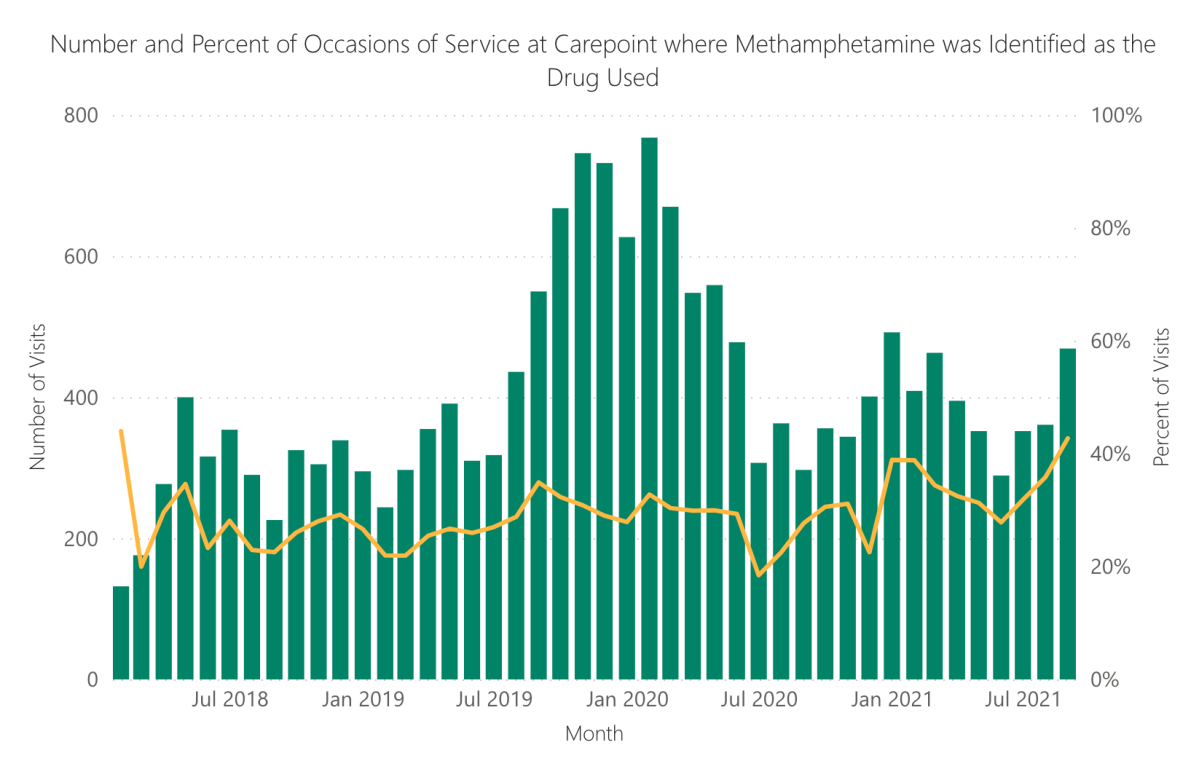Health officials in London, Ont., and Middlesex County have launched a new surveillance system that aims to track the fatal and non-fatal impacts of crystal methamphetamine use in the region while identifying potential areas for intervention.

The Middlesex-London Health Unit (MLHU) is presenting the new system in a report to its Board of Health on Thursday night, which describes the drug as “a present and emerging issue in the region.”
The system is available now to the public in the form of a six-page virtual dashboard on the MLHU website.
In a summary attached to Thursday’s presentation, the MLHU notes that local methamphetamine toxicity death rates more than tripled from 2018 to 2020, a time period in which death rates were also “significantly higher” than those across Ontario.
“The rate reported in Middlesex-London in 2020 was 2.8 times higher than the rate across the rest of Ontario,” the summary added.
A similar trajectory was found in stimulant toxicity deaths involving methamphetamine across Canada, with the death rate jumping from 43 per cent in 2018 to 47 per cent in 2020, according to the MLHU.
The MLHU also found that “during the COVID-19 pandemic, there has been a significant increase in stimulants contributing to opioid-related deaths (50.0 per cent to 58.1 per cent, p<0.01), specifically cocaine and methamphetamine.”
![Click to play video: '‘Crystal [meth] was my everything, now I’m just better off dead’: letter by Kingston stabbing suspect uncovered'](https://i1.wp.com/media.globalnews.ca/videostatic/news/zkz840vo27-kd1mxe2r3w/web-6Tu-MURDER_PARENTS-PKG2_thumbnail_1280x720.jpg?w=1040&quality=70&strip=all)
Across Ontario, methamphetamine directly contributed to more than 25 per cent of opioid-related deaths during the pandemic, up from 23 per cent before the pandemic, the MLHU said.

Get weekly health news
“Similarly, across Canada, 52% of opioid toxicity deaths in 2020 also involved a stimulant,” the summary said.
“These findings may be reflective of increased availability of methamphetamine within the drug supply, and potential polysubstance use throughout the pandemic.”
MLHU’s medical officer of health Dr. Chris Mackie says a surveillance system for crystal methamphetamine use is needed because the harms are much more complex.
“With crystal meth, overdose doesn’t necessarily result in death, usually it doesn’t,” Mackie said. “It can result in lots of problematic health behaviours, disruptive behaviours, all sorts of consequences, so it’s a more complicated problem to monitor and surveil.”

More than 20 organizations provided consultation for the system, including London InterCommunity Health Centre, the City of London, London Police, Western University and Regional HIV/AIDS Connection (RHAC).
RHAC’s Carepoint Consumption and Treatment Service, which opened as the temporary overdose prevention site at 186 King St. in 2018, supplies the data fuelling the online dashboard.
Megan Van Boheemen manages harm reduction services at Carepoint and says that while it provides a low-barrier, confidential and anonymous service, people are asked what substance they’re using when they access the site.
“It’s a snapshot of only those people coming in, but it does give us a snapshot of drug trends in the community,” Van Boheemen said.
Although it focuses on crystal methamphetamine, Van Boheemen says the dashboard can also help in tackling other harm reduction issues, such as the ongoing opioid crisis.
“When we’re seeing the number of people using crystal meth is increasing, that speaks to a lot of things, things like supply chain and what safe products are being available to people who need to use it,” Van Boheemen said.
“We’ve seen an increase in poverty, we’ve seen a decrease in services available to people, we’ve seen an unsafe supply of drugs that are out there on the street that people are using. It all compounds and works together, and I think as a harm reduction service, our whole goal is to get people talking about this.”
Another benefit comes in the data local agencies can now present to potential funders.
“It really puts numbers to what we have been seeing historically for years,” Van Boheemen said. “When we have these numbers, it allows us to basically prove what we’ve been saying and get the resources that we need to support people.”
As for next steps, the MLHU says it will consult with local community members who use methamphetamine in order to better understand the harms of its use and “assess how the surveillance of crystal methamphetamine morbidity data could be meaningfully actioned in the Middlesex-London region.”
The online dashboard will be routinely updated and the MLHU hopes its findings “will also play an important role in identifying and prioritizing issues of public health significance.”













Comments